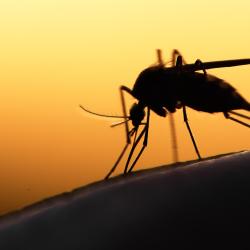New Research Identifies How Blind Cavefish Lose Their Eyes
NIH-led study yields potential clues for understanding eye disease and blindness in people
Blind cavefish (Astyanax mexicanus) lose critical eye tissues within a few days after their eyes begin to develop. According to a new study, this loss of eye tissues happens through epigenetic silencing of eye-related genes. Epigenetic regulation is a process where genes are turned off or on, typically in a reversible, temporary manner. This mechanism differs from genetic mutations, which are permanent changes in the DNA code.
The study, led by researchers at the National Institutes of Health (NIH) in collaboration with University of Maryland Biology Professor William Jeffery and Postdoctoral Researcher Li Ma, identified roles for more than two dozen genes that are shared by humans—most of which have been implicated in various human eye disorders. The paper was published on May 28, 2018 in the journal Nature Ecology & Evolution.
“Our study shows how a single gene can have multiple roles in generating blindness in cavefish by simultaneously silencing the function of many downstream genes,” Jeffery said. “Since most of the silenced genes also cause human eye diseases, our study has importance to biomedicine, as well as for understanding the evolution of eye loss in dark caves.”
A. mexicanus is a tropical freshwater fish native to Mexico. A few million years ago, some of these fish presumably got trapped in dark caves and gave rise to completely different varieties, or “morphs,” that lack eyes and have several other unique physical, behavioral and physiological changes. Despite their dramatic differences, surface and cave morphs share similar genomes and can interbreed. Cave morphs begin eye development early but fail to maintain this program, undergoing eye degeneration within a few days of development. Previous research has not revealed any obvious mutations in genes important for their eye development.
The new study shows that epigenetic-based silencing of a large set of genes limits the eye development of cave-dwelling A. mexicanusfish. Of these genes, 26 are also expressed in human eyes, with 19 of these linked to human eye disorders.
“Subterranean animals provide a unique opportunity to study how animals thrive in extreme environments, some of which can mimic human disease conditions,” said Brant Weinstein, senior investigator at NIH’s Eunice Kennedy Shriver National Institute of Child Health and Human Development (NICHD) and one of the study authors. “Many of the cavefish genes identified in our study are also linked to human eye disorders, suggesting these genes are conserved across evolution and may be similarly regulated in people.”
The study team found more DNA methylation— an epigenetic process in which tags called methyl groups modify DNA—of eye development genes. They also observed less activity of these methylated genes in cavefish. Methyl groups, which are added by proteins called DNA methyltransferases, silence genes by making the DNA inaccessible.
The authors found that cavefish have higher levels of a DNA methyltransferase, called DNMT3B, in their developing eyes. When the study team introduced a disabling mutation into DNMT3B in zebrafish—a different type of fish with normal eyes—they found that the mutant zebrafish had more active eye genes and larger eyes. The results suggest that a genetic change resulting in elevated DNMT3B levels occurred during the evolution of cavefish, leading to epigenetic suppression of eye development genes.
“Our study indicates that small genetic changes that alter epigenetic regulation can play an important role in evolution by triggering dramatic changes in the expression of large sets of genes,” said Aniket Gore, a staff scientist at NICHD and the study’s lead author.
###
This release was adapted from text provided by NIH.
The research paper, “An Epigenetic Mechanism for Cavefish Eye Degeneration,” Aniket Gore, Kelly Tomins, James Iben, Li Ma, Daniel Castranova, Andrew Davis, Amy Parkhurst, William Jeffery and Brant Weinstein, was published in the journal Nature Ecology & Evolution on May 28, 2018.
This work was supported by the National Institutes of Health (Award No. R01EY024941). The content of this article does not necessarily reflect the views of this organization.
Media Relations Contacts:
NICHD: Linda Huynh or Robert Bock, 301-496-5133 nichdpress@mail.nih.gov







